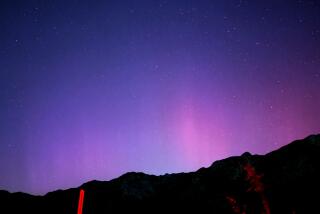Brown dwarf aurora found; could inform exoplanet searches
- Share via
Scientists have detected a powerful glowing aurora in the atmosphere of a celestial body known as a brown dwarf, light-years away from our solar system.
The discovery suggests that when it comes to the behavior of their magnetic fields, brown dwarfs -- objects that are kind of neither here nor there, like stars in some ways and like planets in others -- behave more like Earth than like the sun.
But more broadly, detecting brown dwarf aurorae could have implications for the search for habitable planets outside our solar system, also known as exoplanets, said Caltech astronomer Gregg Hallinan.
“This tells us we can start looking for this kind of activity in planets,” said Hallinan, lead author of a study describing the aurora, published Wednesday in the journal Nature.
Stars have magnetic fields. On our sun, these produce solar flares and coronal mass ejections that send radiation known as solar wind out into space, disrupting electronics here on Earth and threatening the health of travelers in space.
Planets, meanwhile, have magnetic fields too, which help shield them from that solar wind. Earth’s magnetic field directs solar radiation toward the poles, where it excites oxygen atoms in the atmosphere, creating the famous aurorae in the northern and southern skies.
Exoplanet hunters often speak of “Goldilocks” planets, positioned just the right distance from their stars to have liquid water on their surface to harbor life. Another possible prerequisite for life might be a magnetic field to shield a planet from dangerous stellar radiation. If you could find an exoplanet with an aurora, Hallinan figures, that might be a good indication that you’ve found a world that has that protection -- and is, perhaps, habitable.
“We want to understand if other planets have magnetic fields,” Hallinan said.
The one catch? Detecting the light and radio waves created by an aurora from an object as small as a planet is very, very challenging.
That’s where brown dwarfs come in. Too massive to be planets, but not quite massive enough to be blazing stars, they burn a type of hydrogen called deuterium for a while, but then sort of “fizzle out, like the glowing embers of the sky,” Hallinan said.
If brown dwarfs had aurorae, they could provide a guidepost to help scientists begin the search for aurorae on distant planets.
In 2001 astronomers had learned that brown dwarfs emitted radio waves, and initially thought they did so in a pattern similar to that of a star. But about five years later, as a graduate student in Ireland, Hallinan had discovered that brown dwarfs sent out their radio waves in pulses -- just as planets with magnetic fields like Jupiter and Earth do.
That made him and his colleagues think that training radio and optical telescopes on a brown dwarf would allow them to detect a brown dwarf aurora in action. They trained several large, specialized telescopes on LSR J1835 + 3259, a brown dwarf about 18.5 light years from the sun that rotates once every 2.8 hours.
“Sure enough, we saw it,” Hallinan said.
LSR J1835 + 3259’s aurorae, as the team expected, weren’t greenish like Earth’s. Rather, they were reddish, like Jupiter’s -- though far stronger, because the brown dwarf has a much stronger magnetic field than Jupiter does. The researchers did not identify what generated LSR J1835 + 3259’s aurorae.
Now that scientists know they can detect this kind of emission from outside the solar system, Hallinan said, they can begin to “chase planets.”
He said that a new array of 288 radio telescopes that Caltech has installed in the Owens Valley would help his team in that search -- imaging the entire sky, around the clock, every 20 seconds.
For more on science, follow me on Twitter: @LATerynbrown







